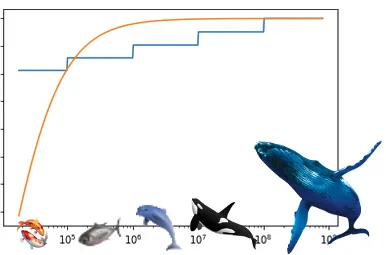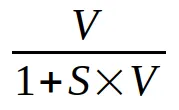
At this moment STEEM has linear rewards. Currently Steemit INC is communicating its support for an Economic Improvement Proposal by @trafalgar, and there is talk of moving from linear to convergent linear rewards .
In a blog by @vandeberg, it is made clear what type of curve Steemit Inc is looking at for implementing this proposal.
Many people reading Steemit Inc's blog or the one by @vandeberg will get lost in the way the rewards are explained. In this post I want to try and explain how the proposed convergent linear proposal would differ from the current linear model. In the current model a vest is a vest or one point of steem power is one point of steem power no matter how many vests or steem power you have (1 SP is approximately 2000 vest). So if we look at the value of every little bit your vesting power as function of how many of these little bits you own, this value, with respect to the rewards system can be expressed simply as:

Now in the proposals that Steemit Inc has gaven its public support for, it seems Steemit Inc wants to replace this fair and simple but arguably somewhat problematic function by the following:

What is important to understand about this formula is that we have some kind of scaling constant S, and for smaller values of V (our vesting shares), this formula is dominated by the 1 below the division line, while at higher values of V the part above and the part below the division converge to being almost equal so the result of the equation converges towards one. This sounds sorta like a reasonable curve to solve the problem of larger stake holders setting up armies of puppet accounts and breaking the system in all sorts of patterns of bad behavior. But there is a problem with the math, a serious problem with the math. The problem is, this curve is in no way a scaling curve. Dimension the curve to incentify dolphins not to break up their stake into hundreds of redfish account and you will have near to nothing to incentify orca's not to break up their stake into hundreds of minnow accounts, let alone whales. Dimension the curve to incentify orca's not to break up their stake into hundreds of minnow accounts, and you will screw over redfish accounts so badly that the incentive for new users to join the platform should become close to zero.
So what are the alternatives? Can we devise a scaling curve or other reward scaling function that actually scales and is fair in that in incentivies dolphins, orcas and whales alike without totally screwing over new users?
My proposal proposes to start of with the following scaling curve:

This curve would result an incentive that scales equally for each fish size and doesn't hit new account as hard as any of the envisioned curves for the convergent linear reward. The scaling factor S here is a bit different than the one in the previous equation. In this equation S is a scaling factor slightly higher than one (for example 1.01, 1.025 or 1.05).
Remember, in the STEEM ecosystem the concept of fish-size has meaning to the community. What the above formula tells us that for an S of 1.01, someone with ten times the stake (or one fish size higher) will get a 1% bonus added to the effective value of his stake. As fish sizes align on vest at powers of ten, we can make the above more in line with how users experience the platform, while at the same time incentify users to buy more SP and power up further to the next fish size level.

By adding the floor function to our curve, our reward scaling curve stops being a smooth curve, and instead gets properties that should be easyer to explain to the comunity. We keep the scaling property of the previous curve, but we also add a bit of user experience improvement. The above reward scaling formula for an S of 1.01 simply translates to a one percent fish-size bonus for every fish-size transition.
In the below graph we see a scaling function for a convergent lineair reward (orange) compared to a scaling function for a fish-size bonus (blue). I've put in the different fish sizes to illustrate the difference in a way I hope everyone can grasp.

I hope that in this blog I have shown the flaws of the convergent linear approach for the reward curve and have shown that a fish-size bonus reward scaling function could be fair, simple and scalable across all fish sizes while at the same time create extra insentive for users approaching the next fish size to buy some extra STEEM and power up.